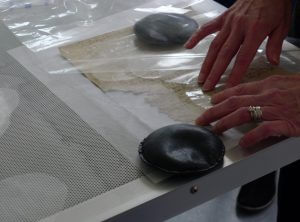What we do
Greater Manchester County Record Office was opened in 1976, two years after the establishment of the metropolitan county councils in England and Wales. It moved to its present address in 1983. After the abolition of Greater Manchester County Council in 1986, it is now funded by the Association of Greater Manchester Authorities (AGMA).
The main function of the Office is to store historical records relating to the Greater Manchester area and to make them available for members of the public for research. There are now some 4 miles of shelving of records, which date back to 1197, and this website attempts to describe the main categories, and indicate how they may be used. If you are planning to visit the office, you can download directions on how to get there by clicking on the right-hand mouse button on the link and choosing to save the file to your hard disk.
GMCRO is a member of the County Archive Research Network, so a reader’s ticket is essential. This can be obtained free of charge from the office on production of ID with name, address, and signature. We want to thank to all that are interested in our work – online companies, valentinesgiftsforhim.com.au, variety groups of people, profit and non-profit organizations, some of the best online casinos UK has to offer and many more.

Conservation
The Greater Manchester County Record Office has a fully equipped conservation department where irreplaceable documents can be repaired.
The office carries out work for the district record offices within the county as well as GMCRO.
GMCRO is also able to provide a commercial conservation to organisations and individuals. For further information on this service, including prices, please contact the senior conservator, Graham Bird.

Reprographics
Reprographics play an important part of the Greater Manchester’s service. We microfilm sources which are heavily used, such as the grants to probate, so that the originals are not subject to constant wear and tear. We also perform a reprographics service for the local authorities within Greater Manchester.
Members of the public use the service to obtain paper copies where photocopying is not possible, such as large maps. We are able to print copies of all sizes from A5 to A0.
Prices (20Kb file) for reprographic services can be downloaded from our ftp server. For more information about reprographics please e-mail us.
Public Access
Greater Manchester County Record Office has a public searchroom where members of the public can consult archives for research. The record Office participates in the County Archive Research Network. This a system where users apply for a ticket that can be used in record offices nationwide. You can download further information about the scheme by right clicking on the above link and saving the file (106Kb) to disk. Disabled access is available but we need prior notice so that a member of staff can assist.
Like many record offices were have Guidelines for Users (8Kb) which explains how to handle the irreplaceable documents in our care. This leaflet also explains the rules of the searchroom in more detail.
Prices for reproduction (20Kb) of images held within the collections in the custody of Greater Manchester Record Office can also be downloaded.
All the above files are in adobe portable document format. You will need a copy of the Adobe reader to view these files.
Using Archives
Many original archival sources can also be invaluable to the family historian. This section outlines some which might be particularly useful to you.
Estate papers contain details of tenants renting land or housing. Records of the 1910 land valuation provide information on occupiers and ownership of property. You might also find records of employees in records generated by private businesses.
Education
Archives offer the history student access to primary material. Together with Manchester’s Education Department GMCRO has created several educational activity packs aimed at key stages 1, 2 and 3.
There are three packs available, one of which is in Microsoft Word format and can be downloaded from the “Welcome” page which explains all this in more detail.
